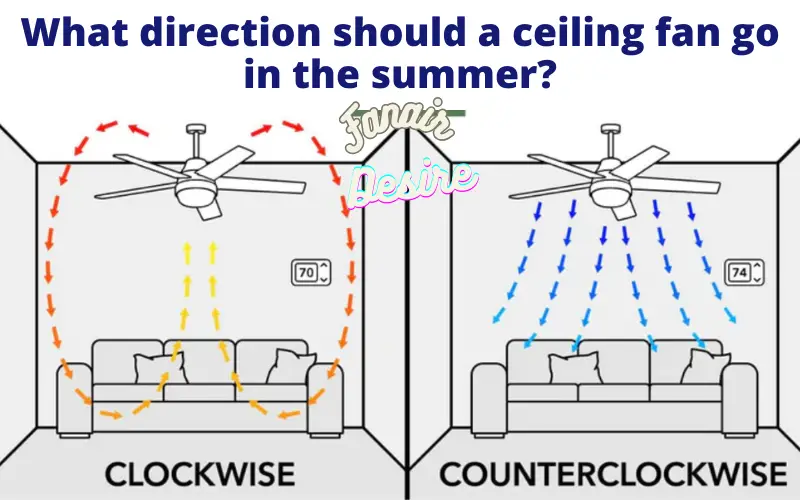Ceiling fans are a popular choice for keeping homes comfortable during the sweltering summer months. However, for many homeowners, the direction in which their ceiling fan should rotate to achieve the best cooling effect remains a mystery. What direction should a ceiling fan go in the summer?
In this comprehensive guide, we’ll not only explain the science behind ceiling fan direction in summer but also provide you with a deeper understanding of how to maximize your fan’s performance for those scorching hot days.
What direction should a ceiling fan go in the summer and winter?
Understanding the Mechanics: How Ceiling Fans Create Comfort
Before we dive into the specifics of ceiling fan direction, let’s establish a solid foundation by exploring how ceiling fans operate.
Unlike air conditioners that actively lower the temperature, ceiling fans work by creating a cooling sensation through improved air circulation and the wind chill effect.
Ceiling fans offer two settings: clockwise (or reverse) and counterclockwise (or forward).
The direction in which your ceiling fan rotates plays a crucial role in determining how effectively it cools your living space.
Summer Comfort: Embracing Counterclockwise Rotation
When summer arrives, it’s time to adjust your ceiling fan to rotate in a counterclockwise direction. This means that, when you look up at your fan from below, the blades should be moving counterclockwise. Here’s why this is essential for optimal summer comfort:
Enhanced Evaporative Cooling: What direction should a ceiling fan go in the summer?
Counterclockwise rotation generates a gentle breeze that accelerates the evaporation of moisture from your skin, producing a cooling sensation. It mimics the refreshing feeling of a light breeze on a hot day.
Even Air Distribution: What direction should a ceiling fan go in the summer?
Counterclockwise rotation forces air downward and outward, creating a convection-like airflow pattern. This helps distribute cooler air uniformly throughout the room, eliminating hot spots.
Energy Efficiency: What direction should a ceiling fan go in the summer?
By using a ceiling fan in conjunction with your air conditioner, you can raise your thermostat’s temperature by a few degrees without sacrificing comfort. The fan’s cooling effect allows you to maintain the same level of comfort while reducing energy consumption and, consequently, your utility bills.
Setting Your Ceiling Fan for a Cool Summer: What direction should a ceiling fan go in the summer?
Now that you’re aware of the benefits of counterclockwise rotation in the summer, here’s how to set your ceiling fan accordingly:
Activate the Fan:
Ensure that your ceiling fan is powered on using either the pull chain or a remote control.
Adjust the Direction:
Most ceiling fans feature a switch on the motor housing that allows you to change the fan’s direction. Typically, this switch has two settings: one for summer (counterclockwise) and one for winter (clockwise).
Confirm the Rotation: What direction should a ceiling fan go in the summer?
To verify that your fan is rotating correctly for summer, stand beneath it and observe the blades. They should be moving in a counterclockwise direction.
Tailor the Speed: What direction should a ceiling fan go in the summer?
Ceiling fans usually offer multiple speed settings. Choose a speed that delivers the desired level of airflow and comfort. Higher speeds create a more noticeable cooling effect.
Dispelling a Common Ceiling Fan Myth
There’s a prevalent misconception that ceiling fans cool down rooms in the same manner as air conditioners. In reality, ceiling fans cool people, not spaces.
They create a cooling sensation on your skin by circulating air effectively, which makes you feel more comfortable in a warm room.
Additional Strategies for Summer Comfort
To further elevate your summer comfort and enhance energy efficiency, consider these supplementary tips:
Selective Usage: What direction should a ceiling fan go in the summer?
Use ceiling fans only in occupied rooms. Turn them off when no one is present to conserve energy.
Multi-Room Installation:
Consider installing ceiling fans in various rooms, including bedrooms, living rooms, and other frequently used areas, to ensure consistent comfort throughout your home.
Leverage Natural Ventilation:
Combine the use of ceiling fans with natural ventilation by opening windows and doors. This encourages the flow of fresh air through your home, maximizing cooling.
Routine Maintenance:
Keep your ceiling fans in top condition by regularly cleaning them and performing maintenance tasks. Dust and debris can accumulate on the blades and inside the motor housing, reducing efficiency.
Conclusion
In the battle against summer heat, your ceiling fan can be your greatest ally. However, its effectiveness hinges on setting it to the correct rotation. Counterclockwise rotation during the summer months is the key to harnessing its cooling potential, creating a more comfortable environment while potentially reducing your energy bills.
By following these straightforward guidelines and understanding the science behind ceiling fan direction, you can enjoy a well-ventilated and cooler living space during even the hottest months. Beat the heat this summer with your ceiling fan set to perfection!

